Clinical Practice: Reflection on an Episode of Care Experience
VerifiedAdded on 2020/10/22
|7
|2029
|136
Report
AI Summary
This report provides a detailed reflection on a clinical practice experience involving a patient with Lewy Body Dementia from Zimbabwe. The student discusses the challenges of communication due to linguistic differences and the patient's beliefs. The report outlines the communication strategies implemented, such as using simplified language, familiar words, and gestures, to build rapport and understand the patient's needs. It also includes a literature review on communication with dementia patients. The student analyzes the experience, highlighting the importance of cultural sensitivity and the need for adaptable communication skills. The report concludes with an analysis of different practices, learning from the experience, and plans for developing communication skills to enhance future practice, including time management and understanding cultural beliefs.
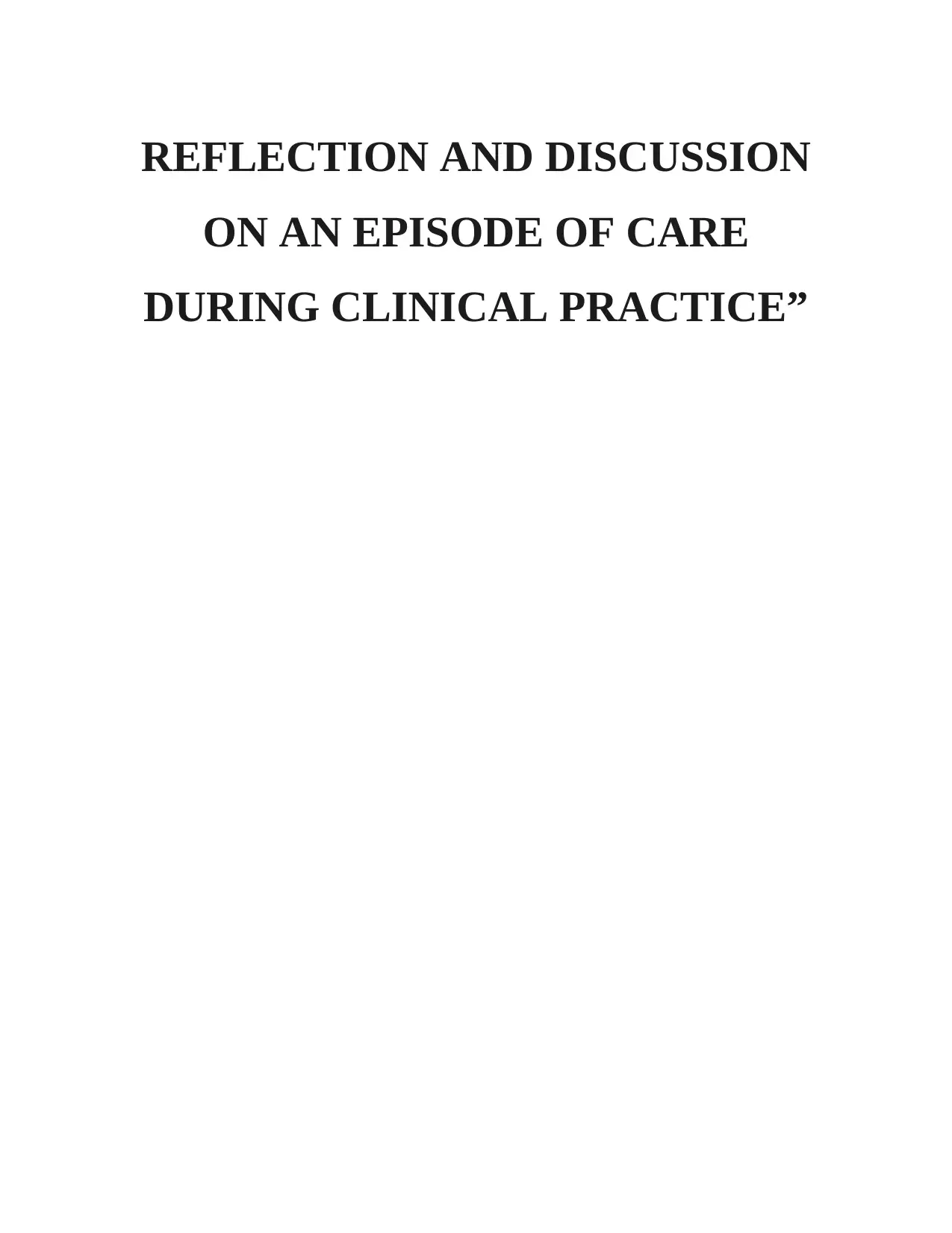
REFLECTION AND DISCUSSION
ON AN EPISODE OF CARE
DURING CLINICAL PRACTICE”
ON AN EPISODE OF CARE
DURING CLINICAL PRACTICE”
Paraphrase This Document
Need a fresh take? Get an instant paraphrase of this document with our AI Paraphraser
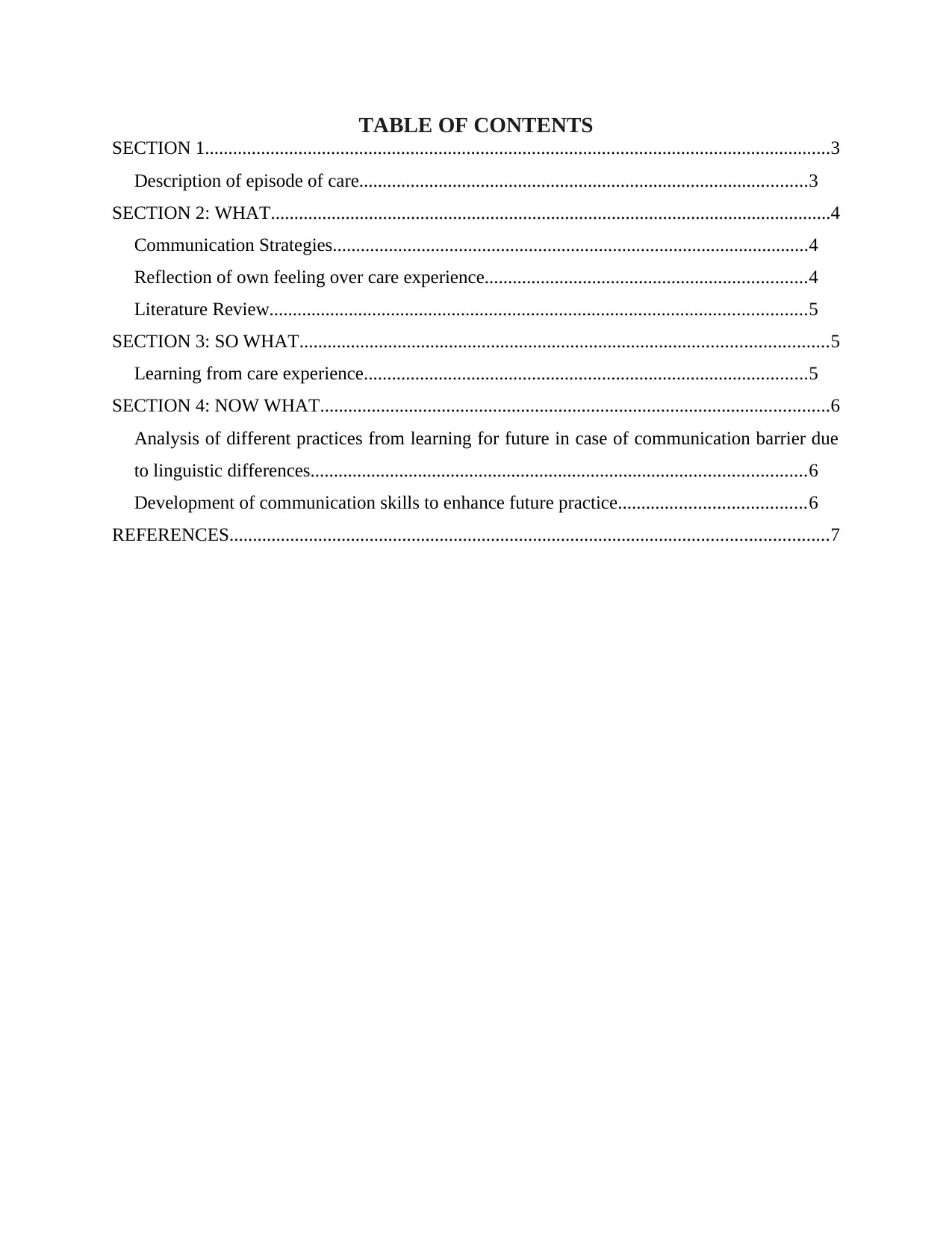
TABLE OF CONTENTS
SECTION 1......................................................................................................................................3
Description of episode of care................................................................................................3
SECTION 2: WHAT........................................................................................................................4
Communication Strategies......................................................................................................4
Reflection of own feeling over care experience.....................................................................4
Literature Review...................................................................................................................5
SECTION 3: SO WHAT.................................................................................................................5
Learning from care experience...............................................................................................5
SECTION 4: NOW WHAT.............................................................................................................6
Analysis of different practices from learning for future in case of communication barrier due
to linguistic differences..........................................................................................................6
Development of communication skills to enhance future practice........................................6
REFERENCES................................................................................................................................7
SECTION 1......................................................................................................................................3
Description of episode of care................................................................................................3
SECTION 2: WHAT........................................................................................................................4
Communication Strategies......................................................................................................4
Reflection of own feeling over care experience.....................................................................4
Literature Review...................................................................................................................5
SECTION 3: SO WHAT.................................................................................................................5
Learning from care experience...............................................................................................5
SECTION 4: NOW WHAT.............................................................................................................6
Analysis of different practices from learning for future in case of communication barrier due
to linguistic differences..........................................................................................................6
Development of communication skills to enhance future practice........................................6
REFERENCES................................................................................................................................7
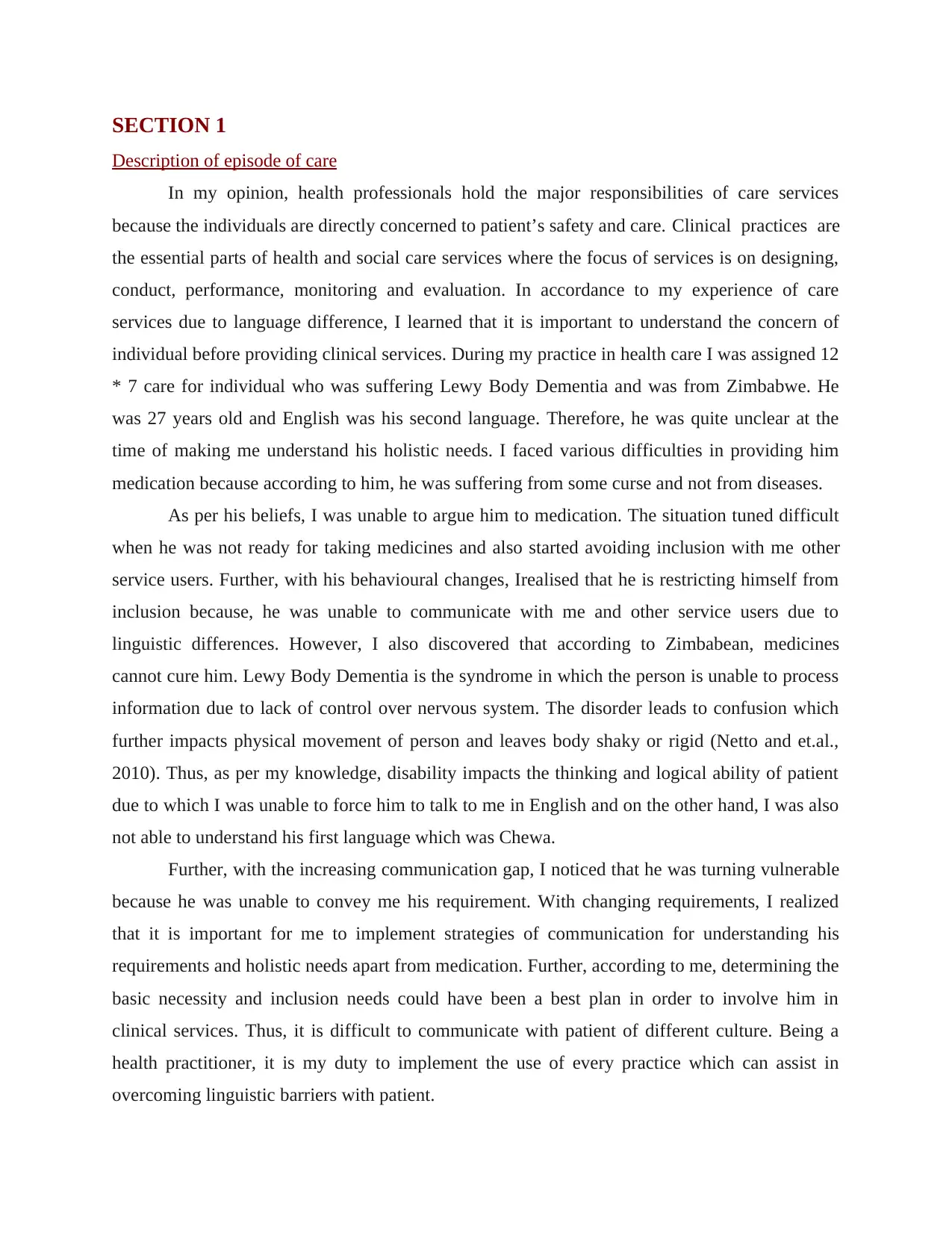
SECTION 1
Description of episode of care
In my opinion, health professionals hold the major responsibilities of care services
because the individuals are directly concerned to patient’s safety and care. Clinical practices are
the essential parts of health and social care services where the focus of services is on designing,
conduct, performance, monitoring and evaluation. In accordance to my experience of care
services due to language difference, I learned that it is important to understand the concern of
individual before providing clinical services. During my practice in health care I was assigned 12
* 7 care for individual who was suffering Lewy Body Dementia and was from Zimbabwe. He
was 27 years old and English was his second language. Therefore, he was quite unclear at the
time of making me understand his holistic needs. I faced various difficulties in providing him
medication because according to him, he was suffering from some curse and not from diseases.
As per his beliefs, I was unable to argue him to medication. The situation tuned difficult
when he was not ready for taking medicines and also started avoiding inclusion with me other
service users. Further, with his behavioural changes, Irealised that he is restricting himself from
inclusion because, he was unable to communicate with me and other service users due to
linguistic differences. However, I also discovered that according to Zimbabean, medicines
cannot cure him. Lewy Body Dementia is the syndrome in which the person is unable to process
information due to lack of control over nervous system. The disorder leads to confusion which
further impacts physical movement of person and leaves body shaky or rigid (Netto and et.al.,
2010). Thus, as per my knowledge, disability impacts the thinking and logical ability of patient
due to which I was unable to force him to talk to me in English and on the other hand, I was also
not able to understand his first language which was Chewa.
Further, with the increasing communication gap, I noticed that he was turning vulnerable
because he was unable to convey me his requirement. With changing requirements, I realized
that it is important for me to implement strategies of communication for understanding his
requirements and holistic needs apart from medication. Further, according to me, determining the
basic necessity and inclusion needs could have been a best plan in order to involve him in
clinical services. Thus, it is difficult to communicate with patient of different culture. Being a
health practitioner, it is my duty to implement the use of every practice which can assist in
overcoming linguistic barriers with patient.
Description of episode of care
In my opinion, health professionals hold the major responsibilities of care services
because the individuals are directly concerned to patient’s safety and care. Clinical practices are
the essential parts of health and social care services where the focus of services is on designing,
conduct, performance, monitoring and evaluation. In accordance to my experience of care
services due to language difference, I learned that it is important to understand the concern of
individual before providing clinical services. During my practice in health care I was assigned 12
* 7 care for individual who was suffering Lewy Body Dementia and was from Zimbabwe. He
was 27 years old and English was his second language. Therefore, he was quite unclear at the
time of making me understand his holistic needs. I faced various difficulties in providing him
medication because according to him, he was suffering from some curse and not from diseases.
As per his beliefs, I was unable to argue him to medication. The situation tuned difficult
when he was not ready for taking medicines and also started avoiding inclusion with me other
service users. Further, with his behavioural changes, Irealised that he is restricting himself from
inclusion because, he was unable to communicate with me and other service users due to
linguistic differences. However, I also discovered that according to Zimbabean, medicines
cannot cure him. Lewy Body Dementia is the syndrome in which the person is unable to process
information due to lack of control over nervous system. The disorder leads to confusion which
further impacts physical movement of person and leaves body shaky or rigid (Netto and et.al.,
2010). Thus, as per my knowledge, disability impacts the thinking and logical ability of patient
due to which I was unable to force him to talk to me in English and on the other hand, I was also
not able to understand his first language which was Chewa.
Further, with the increasing communication gap, I noticed that he was turning vulnerable
because he was unable to convey me his requirement. With changing requirements, I realized
that it is important for me to implement strategies of communication for understanding his
requirements and holistic needs apart from medication. Further, according to me, determining the
basic necessity and inclusion needs could have been a best plan in order to involve him in
clinical services. Thus, it is difficult to communicate with patient of different culture. Being a
health practitioner, it is my duty to implement the use of every practice which can assist in
overcoming linguistic barriers with patient.
⊘ This is a preview!⊘
Do you want full access?
Subscribe today to unlock all pages.

Trusted by 1+ million students worldwide
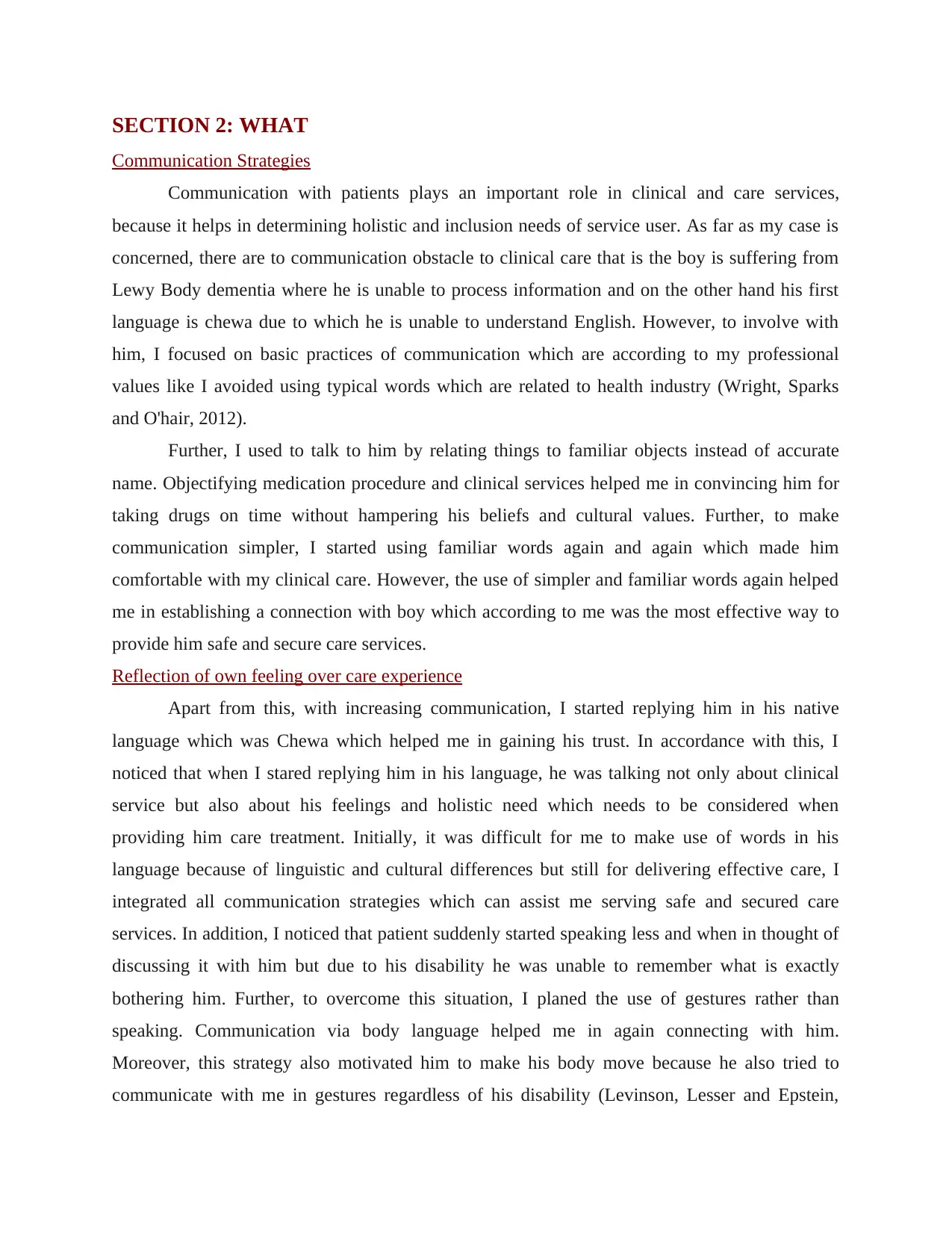
SECTION 2: WHAT
Communication Strategies
Communication with patients plays an important role in clinical and care services,
because it helps in determining holistic and inclusion needs of service user. As far as my case is
concerned, there are to communication obstacle to clinical care that is the boy is suffering from
Lewy Body dementia where he is unable to process information and on the other hand his first
language is chewa due to which he is unable to understand English. However, to involve with
him, I focused on basic practices of communication which are according to my professional
values like I avoided using typical words which are related to health industry (Wright, Sparks
and O'hair, 2012).
Further, I used to talk to him by relating things to familiar objects instead of accurate
name. Objectifying medication procedure and clinical services helped me in convincing him for
taking drugs on time without hampering his beliefs and cultural values. Further, to make
communication simpler, I started using familiar words again and again which made him
comfortable with my clinical care. However, the use of simpler and familiar words again helped
me in establishing a connection with boy which according to me was the most effective way to
provide him safe and secure care services.
Reflection of own feeling over care experience
Apart from this, with increasing communication, I started replying him in his native
language which was Chewa which helped me in gaining his trust. In accordance with this, I
noticed that when I stared replying him in his language, he was talking not only about clinical
service but also about his feelings and holistic need which needs to be considered when
providing him care treatment. Initially, it was difficult for me to make use of words in his
language because of linguistic and cultural differences but still for delivering effective care, I
integrated all communication strategies which can assist me serving safe and secured care
services. In addition, I noticed that patient suddenly started speaking less and when in thought of
discussing it with him but due to his disability he was unable to remember what is exactly
bothering him. Further, to overcome this situation, I planed the use of gestures rather than
speaking. Communication via body language helped me in again connecting with him.
Moreover, this strategy also motivated him to make his body move because he also tried to
communicate with me in gestures regardless of his disability (Levinson, Lesser and Epstein,
Communication Strategies
Communication with patients plays an important role in clinical and care services,
because it helps in determining holistic and inclusion needs of service user. As far as my case is
concerned, there are to communication obstacle to clinical care that is the boy is suffering from
Lewy Body dementia where he is unable to process information and on the other hand his first
language is chewa due to which he is unable to understand English. However, to involve with
him, I focused on basic practices of communication which are according to my professional
values like I avoided using typical words which are related to health industry (Wright, Sparks
and O'hair, 2012).
Further, I used to talk to him by relating things to familiar objects instead of accurate
name. Objectifying medication procedure and clinical services helped me in convincing him for
taking drugs on time without hampering his beliefs and cultural values. Further, to make
communication simpler, I started using familiar words again and again which made him
comfortable with my clinical care. However, the use of simpler and familiar words again helped
me in establishing a connection with boy which according to me was the most effective way to
provide him safe and secure care services.
Reflection of own feeling over care experience
Apart from this, with increasing communication, I started replying him in his native
language which was Chewa which helped me in gaining his trust. In accordance with this, I
noticed that when I stared replying him in his language, he was talking not only about clinical
service but also about his feelings and holistic need which needs to be considered when
providing him care treatment. Initially, it was difficult for me to make use of words in his
language because of linguistic and cultural differences but still for delivering effective care, I
integrated all communication strategies which can assist me serving safe and secured care
services. In addition, I noticed that patient suddenly started speaking less and when in thought of
discussing it with him but due to his disability he was unable to remember what is exactly
bothering him. Further, to overcome this situation, I planed the use of gestures rather than
speaking. Communication via body language helped me in again connecting with him.
Moreover, this strategy also motivated him to make his body move because he also tried to
communicate with me in gestures regardless of his disability (Levinson, Lesser and Epstein,
Paraphrase This Document
Need a fresh take? Get an instant paraphrase of this document with our AI Paraphraser
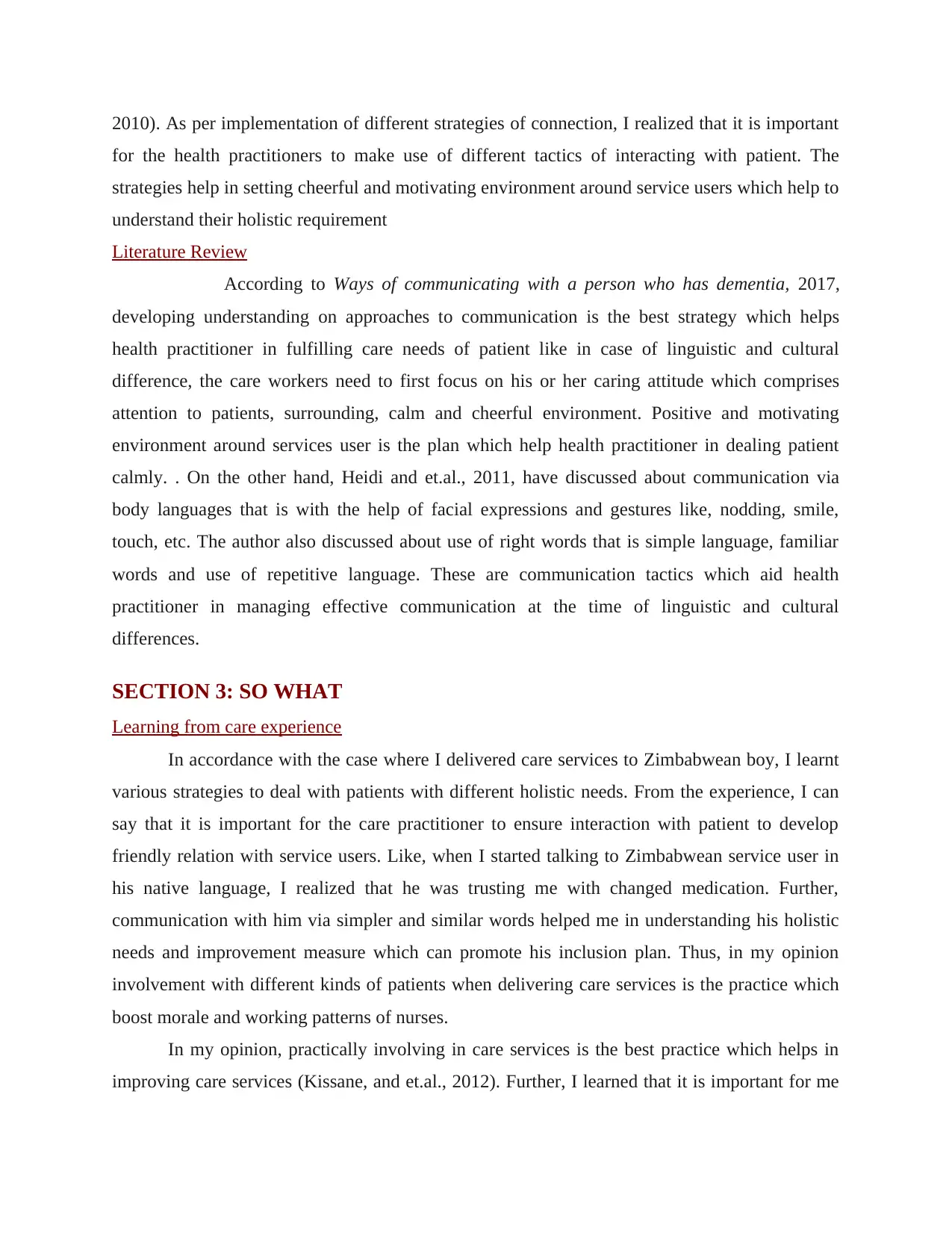
2010). As per implementation of different strategies of connection, I realized that it is important
for the health practitioners to make use of different tactics of interacting with patient. The
strategies help in setting cheerful and motivating environment around service users which help to
understand their holistic requirement
Literature Review
According to Ways of communicating with a person who has dementia, 2017,
developing understanding on approaches to communication is the best strategy which helps
health practitioner in fulfilling care needs of patient like in case of linguistic and cultural
difference, the care workers need to first focus on his or her caring attitude which comprises
attention to patients, surrounding, calm and cheerful environment. Positive and motivating
environment around services user is the plan which help health practitioner in dealing patient
calmly. . On the other hand, Heidi and et.al., 2011, have discussed about communication via
body languages that is with the help of facial expressions and gestures like, nodding, smile,
touch, etc. The author also discussed about use of right words that is simple language, familiar
words and use of repetitive language. These are communication tactics which aid health
practitioner in managing effective communication at the time of linguistic and cultural
differences.
SECTION 3: SO WHAT
Learning from care experience
In accordance with the case where I delivered care services to Zimbabwean boy, I learnt
various strategies to deal with patients with different holistic needs. From the experience, I can
say that it is important for the care practitioner to ensure interaction with patient to develop
friendly relation with service users. Like, when I started talking to Zimbabwean service user in
his native language, I realized that he was trusting me with changed medication. Further,
communication with him via simpler and similar words helped me in understanding his holistic
needs and improvement measure which can promote his inclusion plan. Thus, in my opinion
involvement with different kinds of patients when delivering care services is the practice which
boost morale and working patterns of nurses.
In my opinion, practically involving in care services is the best practice which helps in
improving care services (Kissane, and et.al., 2012). Further, I learned that it is important for me
for the health practitioners to make use of different tactics of interacting with patient. The
strategies help in setting cheerful and motivating environment around service users which help to
understand their holistic requirement
Literature Review
According to Ways of communicating with a person who has dementia, 2017,
developing understanding on approaches to communication is the best strategy which helps
health practitioner in fulfilling care needs of patient like in case of linguistic and cultural
difference, the care workers need to first focus on his or her caring attitude which comprises
attention to patients, surrounding, calm and cheerful environment. Positive and motivating
environment around services user is the plan which help health practitioner in dealing patient
calmly. . On the other hand, Heidi and et.al., 2011, have discussed about communication via
body languages that is with the help of facial expressions and gestures like, nodding, smile,
touch, etc. The author also discussed about use of right words that is simple language, familiar
words and use of repetitive language. These are communication tactics which aid health
practitioner in managing effective communication at the time of linguistic and cultural
differences.
SECTION 3: SO WHAT
Learning from care experience
In accordance with the case where I delivered care services to Zimbabwean boy, I learnt
various strategies to deal with patients with different holistic needs. From the experience, I can
say that it is important for the care practitioner to ensure interaction with patient to develop
friendly relation with service users. Like, when I started talking to Zimbabwean service user in
his native language, I realized that he was trusting me with changed medication. Further,
communication with him via simpler and similar words helped me in understanding his holistic
needs and improvement measure which can promote his inclusion plan. Thus, in my opinion
involvement with different kinds of patients when delivering care services is the practice which
boost morale and working patterns of nurses.
In my opinion, practically involving in care services is the best practice which helps in
improving care services (Kissane, and et.al., 2012). Further, I learned that it is important for me
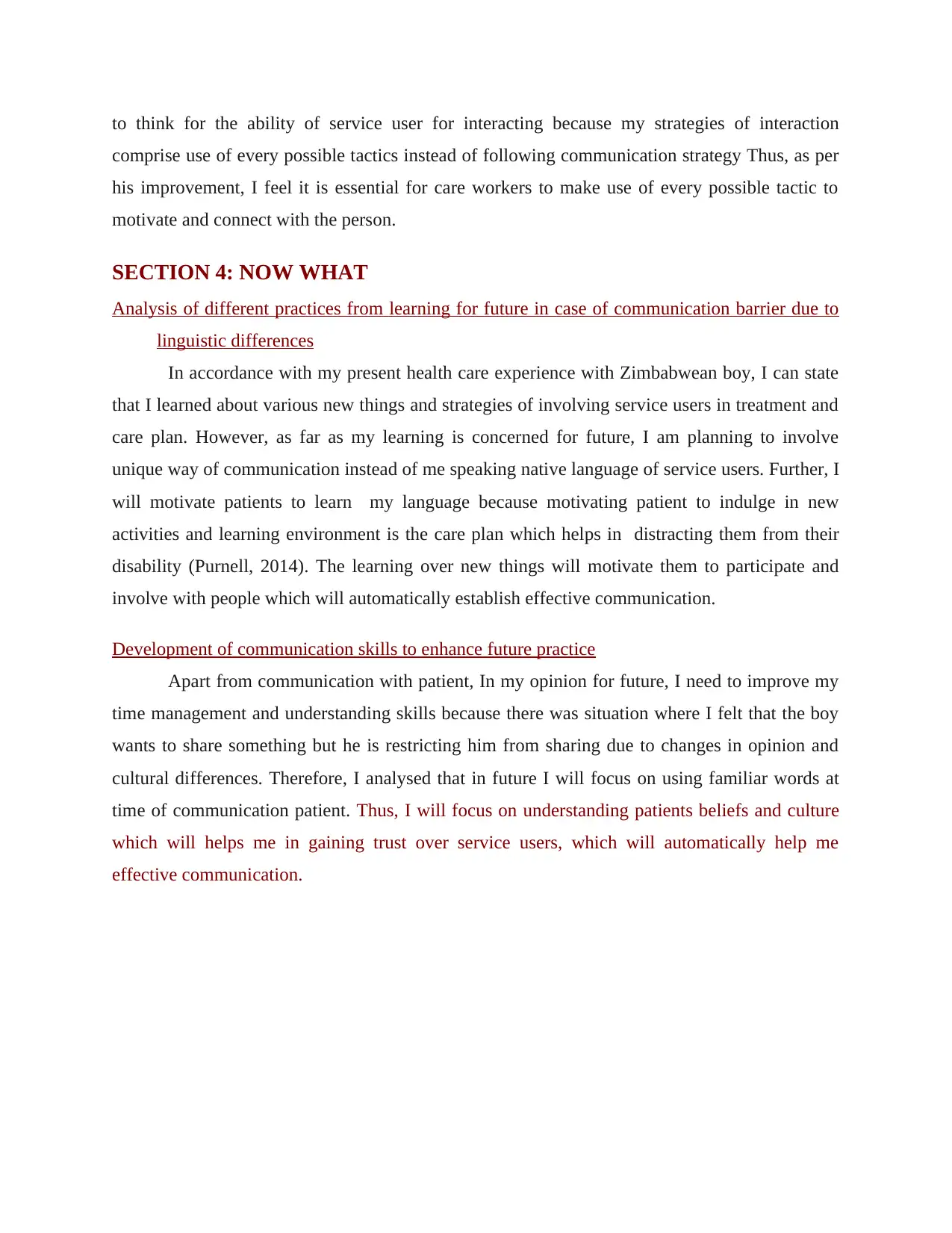
to think for the ability of service user for interacting because my strategies of interaction
comprise use of every possible tactics instead of following communication strategy Thus, as per
his improvement, I feel it is essential for care workers to make use of every possible tactic to
motivate and connect with the person.
SECTION 4: NOW WHAT
Analysis of different practices from learning for future in case of communication barrier due to
linguistic differences
In accordance with my present health care experience with Zimbabwean boy, I can state
that I learned about various new things and strategies of involving service users in treatment and
care plan. However, as far as my learning is concerned for future, I am planning to involve
unique way of communication instead of me speaking native language of service users. Further, I
will motivate patients to learn my language because motivating patient to indulge in new
activities and learning environment is the care plan which helps in distracting them from their
disability (Purnell, 2014). The learning over new things will motivate them to participate and
involve with people which will automatically establish effective communication.
Development of communication skills to enhance future practice
Apart from communication with patient, In my opinion for future, I need to improve my
time management and understanding skills because there was situation where I felt that the boy
wants to share something but he is restricting him from sharing due to changes in opinion and
cultural differences. Therefore, I analysed that in future I will focus on using familiar words at
time of communication patient. Thus, I will focus on understanding patients beliefs and culture
which will helps me in gaining trust over service users, which will automatically help me
effective communication.
comprise use of every possible tactics instead of following communication strategy Thus, as per
his improvement, I feel it is essential for care workers to make use of every possible tactic to
motivate and connect with the person.
SECTION 4: NOW WHAT
Analysis of different practices from learning for future in case of communication barrier due to
linguistic differences
In accordance with my present health care experience with Zimbabwean boy, I can state
that I learned about various new things and strategies of involving service users in treatment and
care plan. However, as far as my learning is concerned for future, I am planning to involve
unique way of communication instead of me speaking native language of service users. Further, I
will motivate patients to learn my language because motivating patient to indulge in new
activities and learning environment is the care plan which helps in distracting them from their
disability (Purnell, 2014). The learning over new things will motivate them to participate and
involve with people which will automatically establish effective communication.
Development of communication skills to enhance future practice
Apart from communication with patient, In my opinion for future, I need to improve my
time management and understanding skills because there was situation where I felt that the boy
wants to share something but he is restricting him from sharing due to changes in opinion and
cultural differences. Therefore, I analysed that in future I will focus on using familiar words at
time of communication patient. Thus, I will focus on understanding patients beliefs and culture
which will helps me in gaining trust over service users, which will automatically help me
effective communication.
⊘ This is a preview!⊘
Do you want full access?
Subscribe today to unlock all pages.

Trusted by 1+ million students worldwide
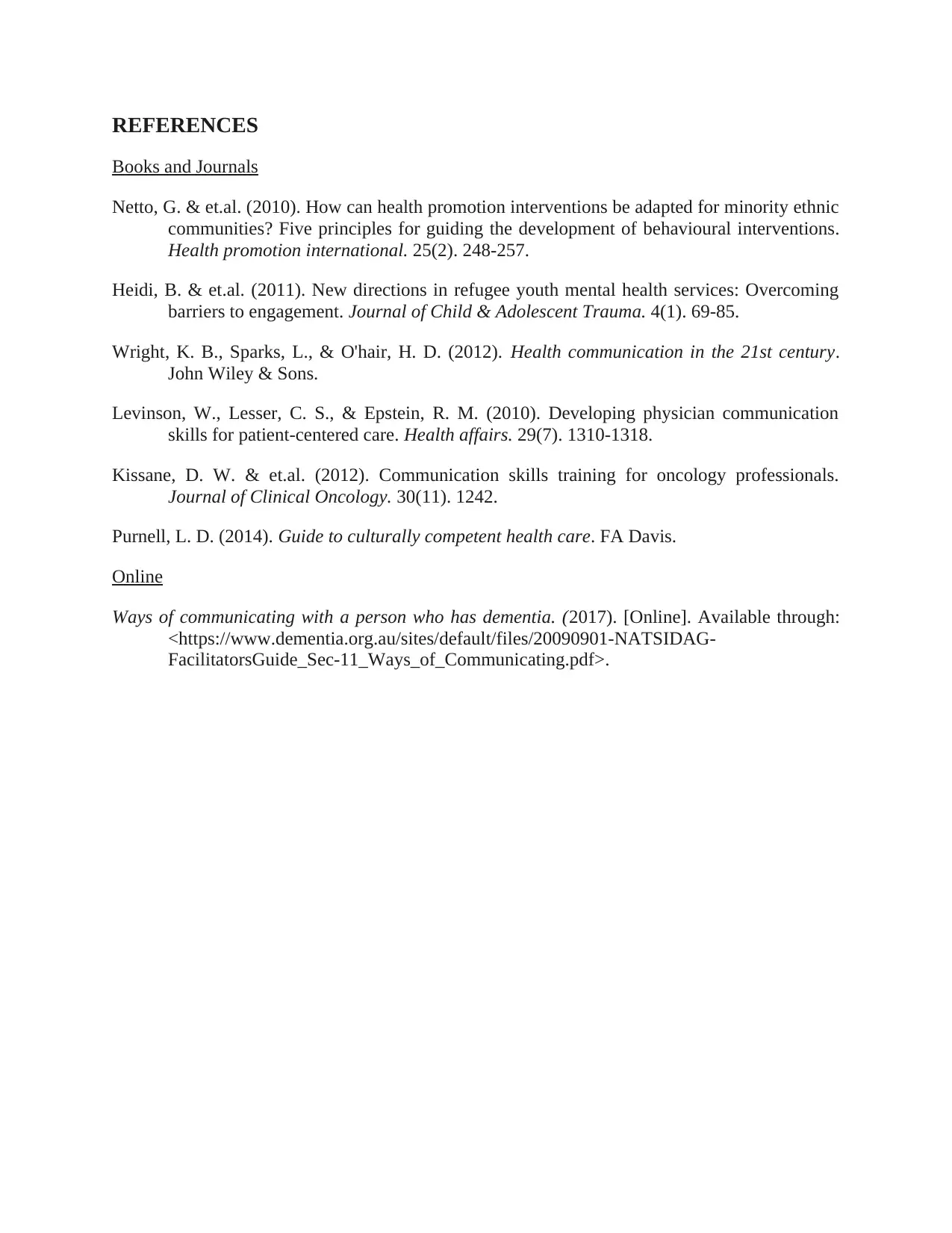
REFERENCES
Books and Journals
Netto, G. & et.al. (2010). How can health promotion interventions be adapted for minority ethnic
communities? Five principles for guiding the development of behavioural interventions.
Health promotion international. 25(2). 248-257.
Heidi, B. & et.al. (2011). New directions in refugee youth mental health services: Overcoming
barriers to engagement. Journal of Child & Adolescent Trauma. 4(1). 69-85.
Wright, K. B., Sparks, L., & O'hair, H. D. (2012). Health communication in the 21st century.
John Wiley & Sons.
Levinson, W., Lesser, C. S., & Epstein, R. M. (2010). Developing physician communication
skills for patient-centered care. Health affairs. 29(7). 1310-1318.
Kissane, D. W. & et.al. (2012). Communication skills training for oncology professionals.
Journal of Clinical Oncology. 30(11). 1242.
Purnell, L. D. (2014). Guide to culturally competent health care. FA Davis.
Online
Ways of communicating with a person who has dementia. (2017). [Online]. Available through:
<https://www.dementia.org.au/sites/default/files/20090901-NATSIDAG-
FacilitatorsGuide_Sec-11_Ways_of_Communicating.pdf>.
Books and Journals
Netto, G. & et.al. (2010). How can health promotion interventions be adapted for minority ethnic
communities? Five principles for guiding the development of behavioural interventions.
Health promotion international. 25(2). 248-257.
Heidi, B. & et.al. (2011). New directions in refugee youth mental health services: Overcoming
barriers to engagement. Journal of Child & Adolescent Trauma. 4(1). 69-85.
Wright, K. B., Sparks, L., & O'hair, H. D. (2012). Health communication in the 21st century.
John Wiley & Sons.
Levinson, W., Lesser, C. S., & Epstein, R. M. (2010). Developing physician communication
skills for patient-centered care. Health affairs. 29(7). 1310-1318.
Kissane, D. W. & et.al. (2012). Communication skills training for oncology professionals.
Journal of Clinical Oncology. 30(11). 1242.
Purnell, L. D. (2014). Guide to culturally competent health care. FA Davis.
Online
Ways of communicating with a person who has dementia. (2017). [Online]. Available through:
<https://www.dementia.org.au/sites/default/files/20090901-NATSIDAG-
FacilitatorsGuide_Sec-11_Ways_of_Communicating.pdf>.
1 out of 7
Related Documents
Your All-in-One AI-Powered Toolkit for Academic Success.
+13062052269
info@desklib.com
Available 24*7 on WhatsApp / Email
![[object Object]](/_next/static/media/star-bottom.7253800d.svg)
Unlock your academic potential
Copyright © 2020–2025 A2Z Services. All Rights Reserved. Developed and managed by ZUCOL.




